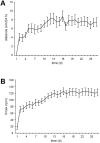Pre-infection physical exercise decreases mortality and stimulates neurogenesis in bacterial meningitis
- PMID: 22781194
- PMCID: PMC3419614
- DOI: 10.1186/1742-2094-9-168
Pre-infection physical exercise decreases mortality and stimulates neurogenesis in bacterial meningitis
Abstract
Physical exercise has been shown to increase neurogenesis, to decrease neuronal injury and to improve memory in animal models of stroke and head trauma. Therefore, we investigated the effect of voluntary wheel running on survival, neuronal damage and cell proliferation in a mouse model of pneumococcal meningitis. Mice were housed in cages equipped with voluntary running wheels or in standard cages before induction of bacterial meningitis by a subarachnoid injection of a Streptococcus pneumoniae type 3 strain. 24 hours later antibiotic treatment was initiated with ceftriaxone (100 mg/kg twice daily). Experiments were terminated either 30 hours or 4 days (short-term) or 7 weeks (long-term) after infection, and the survival time, inflammatory cytokines and corticosterone levels, neurogenesis in the dentate gyrus of the hippocampal formation and the cognitive function were evaluated in surviving mice. Survival time was significantly increased in running mice compared to control animals (p = 0.0087 in short-term and p = 0.016 in long-term experiments, log-rank test). At the end of the long-term experiment, mortality was lower in trained than in sedentary animals (p = 0.031, Fisher's Exact test). Hippocampal neurogenesis--assessed by the density of doublecortin-, TUC-4- and BrdU + NeuN-colabeled cells--was significantly increased in running mice in comparison to the sedentary group after meningitis. However, Morris water maze performance of both groups 6 weeks after bacterial meningitis did not reveal differences in learning ability. In conclusion, physical exercise prior to infection increased survival in a mouse model of bacterial meningitis and stimulated neurogenesis in the dentate gyrus of the hippocampal formation.
Figures




Similar articles
-
Enriched environment fails to increase meningitis-induced neurogenesis and spatial memory in a mouse model of pneumococcal meningitis.J Neurosci Res. 2009 Jun;87(8):1877-83. doi: 10.1002/jnr.22010. J Neurosci Res. 2009. PMID: 19170185
-
Functional analysis of neurovascular adaptations to exercise in the dentate gyrus of young adult mice associated with cognitive gain.Hippocampus. 2009 Oct;19(10):937-50. doi: 10.1002/hipo.20543. Hippocampus. 2009. PMID: 19132736 Free PMC article.
-
Regular voluntary exercise cures stress-induced impairment of cognitive function and cell proliferation accompanied by increases in cerebral IGF-1 and GST activity in mice.Behav Brain Res. 2010 Aug 25;211(2):178-84. doi: 10.1016/j.bbr.2010.03.028. Epub 2010 Mar 20. Behav Brain Res. 2010. PMID: 20307585
-
Cessation of voluntary wheel running increases anxiety-like behavior and impairs adult hippocampal neurogenesis in mice.Behav Brain Res. 2013 May 15;245:34-41. doi: 10.1016/j.bbr.2013.02.009. Epub 2013 Feb 18. Behav Brain Res. 2013. PMID: 23428744
-
Running per se stimulates the dendritic arbor of newborn dentate granule cells in mouse hippocampus in a duration-dependent manner.Hippocampus. 2016 Mar;26(3):282-8. doi: 10.1002/hipo.22551. Epub 2015 Dec 8. Hippocampus. 2016. PMID: 26606164
Cited by
-
Role of the cathelicidin-related antimicrobial peptide in inflammation and mortality in a mouse model of bacterial meningitis.J Innate Immun. 2014;6(2):205-18. doi: 10.1159/000353645. Epub 2013 Aug 22. J Innate Immun. 2014. PMID: 23969854 Free PMC article.
-
Changes in the Proliferation of the Neural Progenitor Cells of Adult Mice Chronically Infected with Toxoplasma gondii.Microorganisms. 2023 Oct 31;11(11):2671. doi: 10.3390/microorganisms11112671. Microorganisms. 2023. PMID: 38004683 Free PMC article.
-
Physical inactivity and long-term rates of community-acquired sepsis.Prev Med. 2014 Aug;65:58-64. doi: 10.1016/j.ypmed.2014.04.017. Epub 2014 Apr 24. Prev Med. 2014. PMID: 24768917 Free PMC article.
-
Lack of formyl peptide receptor 1 and 2 leads to more severe inflammation and higher mortality in mice with of pneumococcal meningitis.Immunology. 2014 Nov;143(3):447-61. doi: 10.1111/imm.12324. Immunology. 2014. PMID: 24863484 Free PMC article.
-
Remembering how to run: A descriptive wheel run analysis in CF1 male and female mice.IBRO Neurosci Rep. 2022 Apr 21;12:333-341. doi: 10.1016/j.ibneur.2022.04.003. eCollection 2022 Jun. IBRO Neurosci Rep. 2022. PMID: 35746966 Free PMC article.
References
-
- Schmidt H, Heimann B, Djukic M, Mazurek C, Fels C, Wallesch CW, Nau R. Neuropsychological sequelae of bacterial and viral meningitis. Brain. 2006;129:333–345. - PubMed
Publication types
MeSH terms
LinkOut - more resources
Full Text Sources

